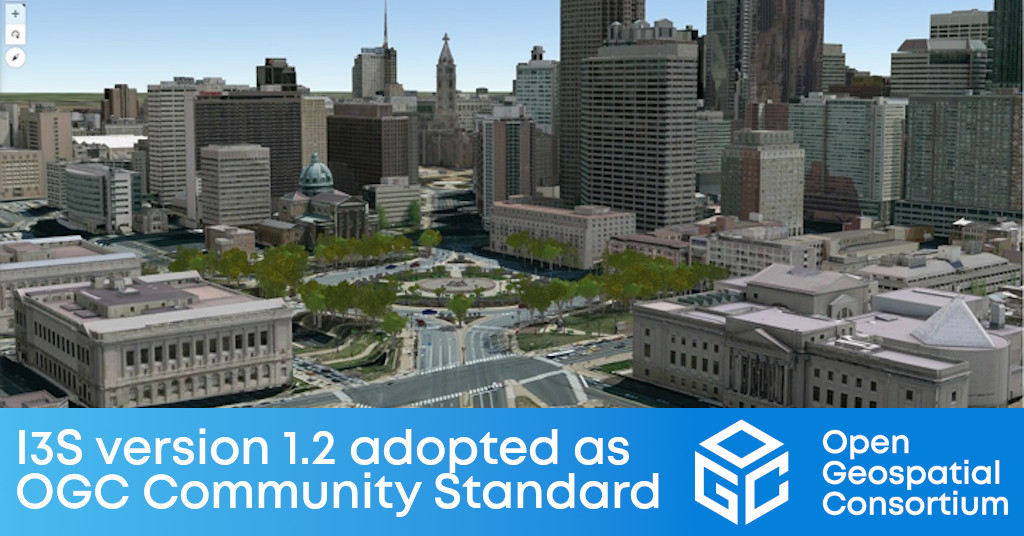Latest version of the I3S Community Standard, used for streaming large 3D datasets to desktop and mobile devices, improves performance and scalability with enhancements to 3D Object and Integrated Mesh layers.

The Open Geospatial Consortium (OGC) is excited to announce that the OGC Membership has approved version 1.2 of the OGC Community Standard Indexed 3D Scene Layer and Scene Layer Package Format Specification, more commonly known as I3S.
I3S enables the streaming and storage of arbitrarily large amounts of 3D geographic data. An I3S dataset, referred to as a Scene Layer, can consist of millions of discrete 3D objects with attributes, integrated surface meshes, symbolized points, or billions of point cloud data covering vast geographic areas. Designed for performance and scalability, a scene layer enables the efficient encoding and transmission of various types of geospatial content for an interactive visualization experience on web browsers, mobile, and desktop apps for both offline and online access. A Scene Layer can be accessed in the form of a web service or Scene Layer Package (SLPK) – a file-based exchange format.
I3S is web and cloud friendly and is rooted in modern standards and technological advancements in the areas of 3D graphics, data structuring, and mesh and texture compression. I3S empowers city and local governments, content providers, and GIS professionals to easily share scene layers. Such scene layers can consist of terabytes of nation-wide point cloud coverage, city- and site-scale 3D mesh data collected at frequent intervals, 3D planning scenarios fusing both ‘as built' and modeled information, and more. The increased accessibility and ease of consumption of 3D geospatial content by both domain experts as well as casual users is being rapidly accelerated by standards such as I3S.
The changes included in v1.2 of the OGC I3S Community Standard include:
- Enhanced performance and scalability.
- Introduction of a node paging capability significantly reduces the client-server traffic resulting in significant performance improvement.
- Support for Draco geometry compression. Compression of I3S geometry attributes creates more compact content, which in turn provides a smaller payload, increasing performance.
- Support for supercompression of texture data using the Basis Universal Texture interchange system in the Khronos® KTX™ 2.0 format.
- Support for advanced material definitions such as physically based materials. Feature compatible with Khronos® glTF™ standard.
This version 1.2 of the OGC Community Standard mirrors version 1.7 of the Esri Scene Layers: Service and Package specification. For more information visit the Esri I3S Spec GitHub page.
As with any OGC standard, the open Indexed 3D Scene Layer and Scene Layer Package Format Specification (I3S) Community Standard is free to download and implement. Interested parties can view and download the standard here or from OGC's Indexed 3D Scene Layers (I3S) Community Standard Page.
About OGC
The Open Geospatial Consortium (OGC) is a collective problem-solving community of experts from more than 500 businesses, government agencies, research organizations, and universities driven to make geospatial (location) information and services FAIR – Findable, Accessible, Interoperable, and Reusable.
The global OGC Community engages in a mix of activities related to location-based technologies: developing consensus-based open standards and best-practice; collaborating on agile innovation initiatives; engaging in community meetings, events, and workshops; and more.
OGC's unique standards development process moves at the pace of innovation, with constant input from technology forecasting, practical prototyping, real-world testing, and community engagement.
OGC bridges disparate sectors, domains, and technology trends, and encourages the cross-pollination of ideas between different communities of practice to improve decision-making at all levels. OGC is committed to creating an inclusive and sustainable future.
Visit ogc.org for more info on our work.
“
